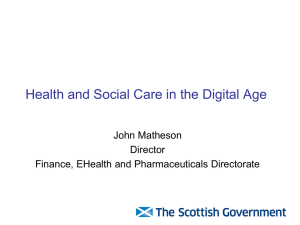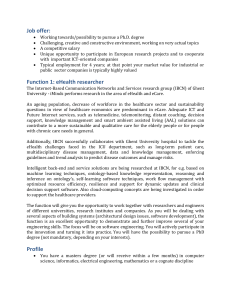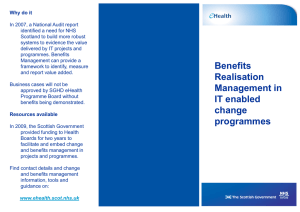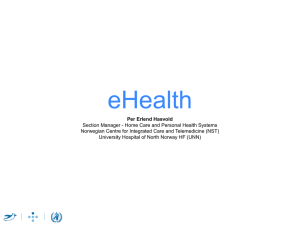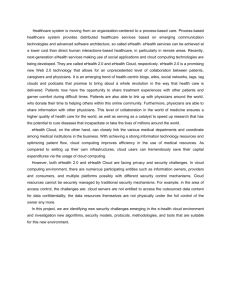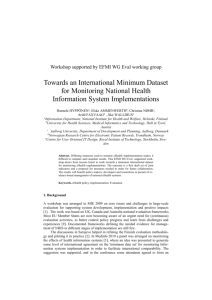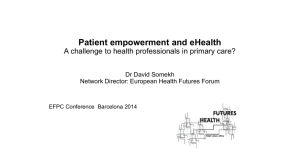What Does This Mean for Disease Management
advertisement
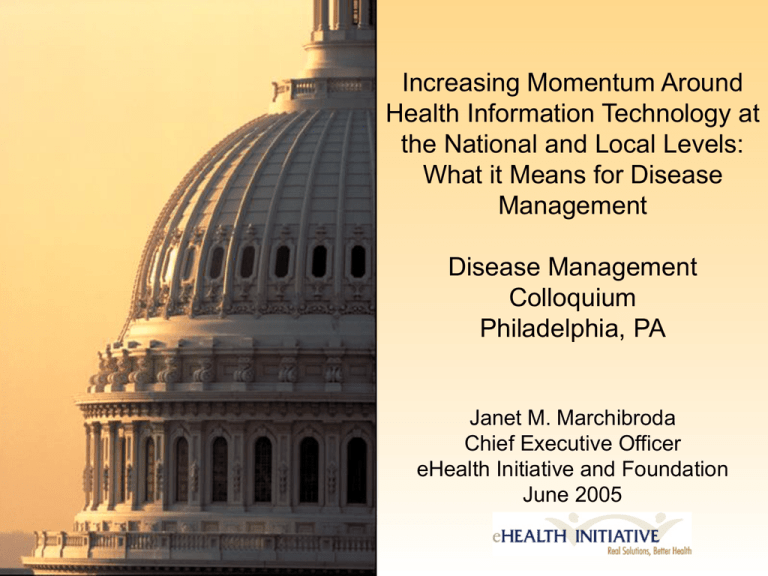
Increasing Momentum Around Health Information Technology at the National and Local Levels: What it Means for Disease Management Disease Management Colloquium Philadelphia, PA Janet M. Marchibroda Chief Executive Officer eHealth Initiative and Foundation June 2005 Overview of Discussion • Understanding the National HIT Agenda: What’s Happening? – Administration – Congress – Private Sector • Overview of State, Regional and Communitybased HIT and Health Information Exchange Initiatives or “RHIOs” • What Does This Mean for Disease Management? © eHealth Initiative 2005 Page 2 Understanding the National Agenda • Enormous momentum around HIT and health information exchange both within Administration and Congress • Key themes – Need for standards and interoperability – clear roadmap – Need for incentives – roadmap not yet clear – National standards – implemented locally within regions – Public-private sector collaboration © eHealth Initiative 2005 Page 3 Two Key Drivers for HIT • Movement on quality, safety and efficiency • Movement on HIT in general – particular focus on interoperability © eHealth Initiative 2005 Page 4 Increasing Interest in Pay for Performance and Quality • Large private sector purchasers and CMS increasing interest in quality within ambulatory care… Bridges to Excellence a key player • National Quality Forum getting consensus on ambulatory care measures • House and Senate considering pay for performance or incentives legislation • MedPAC recommends pay for performance • Budget Reserve Fund offers opportunity for testing financing options © eHealth Initiative 2005 Page 5 Increasing Interest in HIT • Members of Senate and House have also introduced legislation related to HIT….more to come • President created sub-cabinet level position – National Coordinator for Health Information Technology and David J. Brailer, MD, PhD appointed in July 2004 • Secretary Leavitt has made interoperability and HIT a key part of his agenda over the coming year © eHealth Initiative 2005 Page 6 Increased Momentum within Congress • Significant increase in level of activity both within House and Senate • Will see some action this year – HIT legislation – role of government, language related to standards – Pay for performance and incentives for both quality and HIT © eHealth Initiative 2005 Page 7 Legislation Already Introduced • Budget Reserve Fund included in Conference Report • S. 16 - Affordable Health Care Act (Kennedy, D- MA) • S. 544 - Public Health Service Act (Jeffords, Gregg, Enzi, Bingaman, Frist and Murray) • HR 747 - National Health Information Incentive Act (McHugh, R-NY and Gonzalez, D-TX) • 21st Century Health Information Act (Kennedy D-RI, Murphy R-PA) • Health Information Technology Act of 2005 (Stabenow DMI and Snowe) • Health Technology to Enhance Quality Act of 2005 (Frist R-TN, Clinton D-NY) © eHealth Initiative 2005 Page 8 Budget Reserve Fund • The Budget Resolution permits the Committee on Finance or the Committee on Health, Education, Labor, and Pensions to report legislation that — – Provides incentives or other support for adoption of modern information technology to improve quality in health care; and – Provides for performance-based payments that are based on accepted clinical performance measures that improve the quality in healthcare – If such legislation is deficit neutral for the period of fiscal years 2006 through 2010. © eHealth Initiative 2005 Page 9 21st Century Health Information Act • H.R. (Murphy, R-PA and Kennedy, D-RI) – Grants for regional health information exchange networks – Medicare/Medicaid participating physicians using IT – Authorizes certification program for software applications – Federal funds restricted to certified IT products – New exception for Stark and anti-kickback within context of community plan © eHealth Initiative 2005 Page 10 Health Information Technology Act of 2005 (Stabenow, Snowe) • Grants to hospitals ($250m), SNFs ($100m), federally qualified health centers ($40m), physicians, and physician group practices ($400m) • Development and adoption of standards within two years © eHealth Initiative 2005 Page 11 Health Technology to Enhance Quality Act of 2005 (Frist, Clinton) • Authorizes Office of National Coordinator • Sets up collaborative process for identifying and adopting standards • Implements standards (mandatory in federal government, voluntary in private sector) • Designates that private entities will certify • Identifies laws that may be barriers to electronic exchange and provides funding to states to begin harmonizing laws • Authorizes $125 million in grants to local or regional collaborations for HIT infrastructure © eHealth Initiative 2005 Page 12 Health Technology to Enhance Quality Act of 2005 (Frist, Clinton) • Exemptions from Stark & Anti-Kickback laws • Directs HHS, DoD, VA and others to adopt uniform healthcare quality measures – mandatory for government, voluntary for private sector • Establishes collaborative efforts with private sector to encourage use of healthcare quality measures adopted by Secretary • Requires comparative quality reports on federal healthcare programs • Establishes 3 budget neutral value-based purchasing programs for Medicare, Medicaid and Community Health Centers, includes HIT provisions and reporting of quality information © eHealth Initiative 2005 Page 13 Legislation Being Drafted • Healthcare Information Technology Improvement Act of 2005 (Enzi – R-WY) – Authorizes entity to support the development and adoption of standards – Authorizes demonstration programs to support health information networks • Movement in House Ways and Means and Senate Finance on pay for performance © eHealth Initiative 2005 Page 14 Leadership from Administration • President George W. Bush creates new subcabinet level position • Secretary Tommy Thompson appoints David J. Brailer, MD, PhD National Coordinator for HIT • Strategic Framework released in July 2004 • RFP for National Health Information Network released with January 2005 due date…results just released • Secretary Michael Leavitt personally playing a significant role • Four RFP’s released this month © eHealth Initiative 2005 Page 15 DHHS Secretary Leavitt’s 500-Day Plan • • • • • • • • • • Care for the truly needy, foster self-reliance National standards, neighborhood solutions Collaboration, not polarization Solutions transcend political boundaries Markets before mandates Protect privacy Science for facts, process for priorities Reward results, not programs Change a heart, change a nation Value life © eHealth Initiative 2005 Page 16 Secretary Leavitt’s June Announcement • Creation of American Health Information Community (AHIC) – Formed under auspices of FACA, it will provide input and recommendations to HHS on how to make health records digital and interoperable and assure that privacy and security are protected – 17 Commissioners – soliciting nominations from consumer groups, providers, payers, hospitals, vendors, privacy interests, and any other member of public – Dissolution within two to five years with goal of creating selfsustaining, private sector replacement © eHealth Initiative 2005 Page 17 American Health Information Community Deliverables • Adoption of non-governmental standard-setting and certification processes • Groundwork for a national architecture that allows data to be shared securely using the Internet • Applications that provide immediate benefits (drug safety, lab results, bioterrorism surveillance, etc.) • Transition to a private-sector health information community initiative that will provide long-term governance © eHealth Initiative 2005 Page 18 Four RFP’s on Interoperability and Health Information Sharing Policies 1. Contract to develop, prototype, and evaluate feasibility and effectiveness of a process to unify and harmonize industrywide health IT standards development, maintenance and refinements over time – awarded by September 2005 2. Contract to develop, prototype, and evaluate compliance certification process for EHRs, including infrastructure or network components through which they interoperate – awarded by September 2005 © eHealth Initiative 2005 Page 19 Four RFP’s on Interoperability and Health Information Sharing Policies 3. Contract to assess and develop plans to address variations in organization-level business policies and state laws that affect privacy and security practices, including those related to HIPAA – awarded by September 2005 4. Six contracts for the development of designs and architectures that specify the construction, models of operation, enhancement and maintenance, and live demonstrations of the Internet-based NHIN prototype – awarded in FY 2006 © eHealth Initiative 2005 Page 20 U.S. Office of National HIT Coordinator July 2004 Framework for Strategic Action 1. Inform Clinical Practice – – – Incentivize EHR Adoption Reduce risk of EHR investment Promote EHR diffusion in rural and underserved areas 2. Interconnect Clinicians – – – Foster regional collaborations Develop a national health information network Coordinate federal health information systems © eHealth Initiative 2005 Page 21 U.S. Office of National HIT Coordinator July 2004 Framework for Strategic Action 3. Personalize Care – – – Encourage use of PHRs Enhance informed consumer choice Promote use of telehealth systems 4. Improve Population Health – – – Unify public health surveillance architectures Streamline quality and health status monitoring Accelerate research and dissemination of evidence © eHealth Initiative 2005 Page 22 U.S. Agency for Healthcare Research and Quality $139 million in grants and contracts for HIT • Over 100 grants to support HIT – 38 states with special focus on small and rural hospitals and communities - $96 million over three years • Five-year contracts to five states to help develop statewide networks – CO, IN, RI, TN, UT - $25 million over five years • National HIT Resource Center: collaboration led by NORC and including eHealth Initiative, CITL, Regenstrief Institute/Indiana University, Vanderbilt and CSC - $18.5 million over five years © eHealth Initiative 2005 Page 23 Centers for Medicare & Medicaid Services Initiatives Linking Quality and HIT • Section 649 – Pay for Performance Demonstration Programs – link payment to better outcomes and use of HIT – launched last month • Quality Improvement Organizations playing a critical role…. Doctors Office Quality – Information Technology Program (DOQ-IT) – technical assistance for HIT in small physician practices included in eighth scope of work • Chronic Care Demonstration Program – linking payment to better outcomes – IT a critical component • Section 646 “area-wide” demonstration expected this summer © eHealth Initiative 2005 Page 24 Centers for Disease Control and Prevention HIT Initiatives Supporting Public Health CDC launches Biosense Program • National initiative to enhance nation’s capability to rapidly detect, quantify, and localize public health emergencies by accessing and analyzing health data • This program will establish near real-time electronic transmission of data to local, state and federal public health agencies from national, regional and local health data © eHealth Initiative 2005 Page 25 Increased Momentum in Private Sector • Several large employers and health plans now providing incentives to practicing clinicians, hospitals and other providers for improving quality using HIT (e.g. Bridges to Excellence) • Connecting for Health, a public-private collaborative – Roadmap for Electronic Connectivity – 13 organizations collaboratively respond to RFI for National Health Information Network – Prototypes for record locator service • eHealth Initiative’s Connecting Communities for Better Health Program providing seed funding and technical support to states, regions and communities involved in health information exchange • Launch of the Commission Certification for HIT © eHealth Initiative 2005 Page 26 Overview of HIT and Health Information Exchange Activities at the State, Regional and Local Levels © eHealth Initiative 2005 Page 27 Why Health Information Exchange? • U.S. healthcare system highly fragmented….data is stored--often in paper forms—in silos, across hospitals, labs, physician offices, pharmacies, and insurers • Public health agencies forced to utilize phone, fax and mail to conduct public health surveillance, detection, management and response • Physicians spend 20 - 30% of their time searching for information…10 - 81% of the time, physicians don’t find information they need in patient record • Clinical research hindered by paper-based, fragmented systems – costly and slow processes © eHealth Initiative 2005 Page 28 Health Information Exchange Value • Standardized, encoded, electronic HIE would: – Net Benefits to Stakeholders • • • • • Providers - $34B Payers - $22B Labs - $13B Radiology Centers - $8B Pharmacies = $1B – Reduces administrative burden of manual exchange – Decreases unnecessary duplicative tests Center for Information Technology Leadership 2004 © eHealth Initiative 2005 Page 29 Why State and Regional Activities? • Wide-spread recognition of the need for health information technology and exchange/ interoperability at the national level • While federal leadership and national standards are needed, healthcare indeed is local and leadership is needed at the state, regional and community levels across the country • Collaboration and development of consensus on a shared vision, goals and plan is needed among multiple, diverse stakeholders at the state and regional level in order to effectively address healthcare challenges through HIT and health information exchange © eHealth Initiative 2005 Page 30 Source of Data for Following Overview • Qualitative and quantitative data from the following three programs: – eHealth Initiative Foundation’s Connecting Communities for Better Health Program, conducted in cooperation with DHHS (HRSA in years one and two, ONCHIT in year three) – eHealth Initiative’s State and Regional HIT Policy Summit Initiatives – AHRQ National Resource Center for Health Information Technology, of which eHI Foundation is a key partner © eHealth Initiative 2005 Page 31 eHealth Initiative’s Connecting Communities for Better Health Program • $11 million program in cooperation with U.S. Health Resources and Services Administration/DHHS • Provides seed funding to regional and communitybased multi-stakeholder collaboratives that are mobilizing information across organizations • Mobilizes pioneers and experts to develop resources and tools to support health information exchange: technical, financial, clinical, organizational, legal • Disseminates resources and tools and creates a place for learning and dialogue across communities © eHealth Initiative 2005 Page 32 eHI State and Regional HIT Policy Summit Initiative • Extension of eHI’s Connecting Communities for Better Health Program and in collaboration with the Agency for Healthcare Quality Research and Quality National Resource Center. • Catalyzing efforts by supporting dialogue amongst state and regional policy-makers, healthcare leaders and business community on HIT and health information exchange • Raising awareness of legislative or regulatory barriers to the use of HIT and health information exchange at the state level • Bringing the experiences of state and regional experiences to the national policy dialogue on HIT © eHealth Initiative 2005 Page 33 AHRQ National Resource Center for HIT Goal: Increase the adoption of health information systems to improve patient safety and quality of care and conduct research on take-up and impacts • eHealth Initiative Foundation proud partner of AHRQ National Resource Center for HIT which is led by National Opinion Research Center (NORC). Other partners include: • Three academic thought leaders: – Indiana University/Regenstrief – Vanderbilt University – Center for Information Technology Leadership / Partners • Burness Communications: Policy-focused Public Relations • BL Seamon Corporation: Logistical and coordination support • Computer Sciences Corporation: Technology design and support services © eHealth Initiative 2005 Page 34 Stage of Health Information Exchange Programs Stage 1 Stage 2 Stage 3 12% (vs. 23%) 15.5% (vs. 27%) Recognition of the need for HIE among multiple stakeholder s in your state, region, or community Getting Transferring Well underorganized vision, goals, way with Defining & objectives implementat shared to tactics and ion – vision, goals, business technical, & objectives plan financial, Identifying Defining and legal funding needs and sources requirements Setting up Securing legal & funding governance structures 11% (vs. 25%) Stage 4 Stage 5 34% 14% (vs. 16%) (vs. 9%) © eHealth Initiative 2005 Stage 6 12% (new category) Fully operational Demonstration health of expansion of information organization to organization encompass a Transmitting broader data that is coalition of being used stakeholders than present in by the initial healthcare stakeholders operational Sustainable model business model Page 35 Significant Drivers: Rank Order • Inefficiencies experienced by providers • Rising healthcare costs • Increased attention on HIT at national level • Availability of grant funding for HIE • Demand for performance information from purchasers or payers • Public health surveillance © eHealth Initiative 2005 Page 36 Most Difficult Challenges for Health Information Exchange • Securing upfront funding • Achieving sustainability • Understanding the standards • Engaging health plans and purchasers in coverage area • Accurately linking patient data • Addressing technical aspects • Engaging labs in your coverage area © eHealth Initiative 2005 Page 37 Other Key Barriers • • • • • • • Lack of standards Lack of trust Issues around data ownership Lack of awareness about importance High vendor implementation cost Product maturity Concerns about migration for small physician practices © eHealth Initiative 2005 Page 38 Functionalities of Health Information Exchange Initiatives • • • • • • • • • Repository Clinical documentation Consultations or referral Results delivery Enrollment checking & eligibility Quality performance reporting Alerts to providers Disease or chronic care management Public health surveillance © eHealth Initiative 2005 Page 39 Data Currently Provided or Expected to Provide Within Six Months • • • • • • • • • • Laboratory Enrollment/eligibility Outpatient episodes Inpatient episodes Radiology Pathology Claims ED episodes Dictation/transcription Prescription information © eHealth Initiative 2005 Page 40 Technical Model and Architecture: Fairly Evenly Distributed Across All • Fully integrated repository or database • Federated database with differing data models and standardized middleware • Federated with heterogeneous software using a standardized data model • Federated with homogenous data repositories © eHealth Initiative 2005 Page 41 Emerging Guiding Principles • Approach for Organizing Work – HIT adoption and health information exchange will require local / regional collaboration; a “state-wide, onesize-fits-all” approach will not work – Incremental; no “big bang” approach – Minimally invasive with limited disruptions – Recognized need for state-wide dialogue, collaboration and coordination – Also great interest in sharing of resources, insights and tools to support implementation by stakeholders in different parts of the region © eHealth Initiative 2005 Page 42 Emerging Guiding Principles (cont) • Organization and Governance Attributes – Convening by trusted, neutral party – Representation of all of the diverse stakeholders; “fair” governance – Members in it for the “long haul” – Strive for consensus – Open disclosure of biases and interests – Shared vision and goals – Engagement of consumers and patients critical © eHealth Initiative 2005 Page 43 Emerging Guiding Principles (cont) • Sharing Burden and Benefits – Must create value for all participants – Critical to demonstrate value both globally and for each stakeholder interest – Must address the highly competitive environment – Look for incremental value gains – projects that will immediately return value – as you move towards your longer-term goal © eHealth Initiative 2005 Page 44 Emerging Guiding Principles (cont) • Financing and Sustainability – Focusing on what is possible – Phasing out rewards for acquisition and use, phasing in rewards for performance – Small grants for large purchases may not work – Giveaway programs have had little impact – Coordination and collaboration within the region or community is critical – Incentive amounts offered should be meaningful © eHealth Initiative 2005 Page 45 Emerging Guiding Principles (cont) • Financing and Sustainability – Purchaser or payer sponsors of the incentive program should represent a meaningful proportion of the clinician’s patient panel – Any applications covered by the program should be “interoperable” and standards-based – Certification and accreditation can offer purchasers and payers confidence – Emerging health information exchange initiatives, networks and organizations should be leveraged to facilitate effective and efficient information sharing © eHealth Initiative 2005 Page 46 Benefits of Coordination and Collaboration Within Markets • Widespread of adoption of HIT across physician practices may not be possible without broadbased community collaboration and coordination • Physician practices ordinarily contract with a large number of purchasers and payers • As a result, incentives offered by a small number of purchasers or payers generally are not effective • In addition, most of the data required to deliver care within physician practices resides somewhere else © eHealth Initiative 2005 Page 47 Benefits of Coordination and Collaboration Within Markets • Providing leverage to achieve widespread participation • Reducing the potential for the “free rider” effect • Reducing burden created by physician practices participating in multiple reporting initiatives • Significantly reducing per participant cost of both transmitting and receiving common data elements for various healthcare needs © eHealth Initiative 2005 Page 48 What Does This Mean for Disease Management? • Lots of change and movement in this area over the next 12 months – Nationally – at the federal level – Many, many states and regions kicking off projects © eHealth Initiative 2005 Page 49 What Does This Mean for Disease Management • Enormous opportunity to improve efforts around chronic care and disease management • More timely and accurate information about the patient….and about clinical knowledge where it is needed most….at the point of care • Will help us to close the gap between clinical knowledge and actions taken at the point of care • Increased transparency and accountability around quality and efficiency • Better access to information to support the physician patient relationship • Will ultimately enable patients to better navigate the healthcare system with more information • Will support alignment of incentives with quality and efficiency goals © eHealth Initiative 2005 Page 50 In Closing… • We are finally building momentum • The focus has shifted from “whether we should” to “how will we do this?” • This work will create lasting and significant changes in the U.S. healthcare system…how clinicians practice…how hospitals operate….how healthcare gets paid for…how patients manage their health and navigate our healthcare system © eHealth Initiative 2005 Page 51 Janet M. Marchibroda Chief Executive Officer eHealth Initiative and Foundation www.ehealthinitiative.org 1500 K Street, N.W., Suite 900 Washington, D.C. 20005 202.624.3270 Janet.marchibroda@ehealthinitiative.org © eHealth Initiative 2005 Page 52
